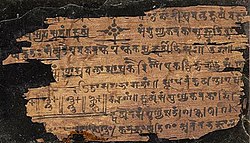| Bakhshali manuscript | |
|---|---|
| Bodleian Library, University of Oxford | |
 One of the Bakhshali manuscripts. | |
| Type | Mathematical text |
| Date | AD 224–383/ 885–993 (proposed carbon-dates, recently disputed on methodological grounds: Plofker et al. 2017,[1] Houben 2018 §3[2]) |
| Place of origin | Bakhshali, (present-day) Pakistan |
| Language(s) | Sanskrit with influence from local dialects |
| Material | Birch bark |
| Format | Seventy leaves |
| Condition | Too fragile to be handled[3] |
| Script | Sharada script |
| Contents | maths text |
| Discovered | 1881 |
The Bakhshali manuscript is an ancient Indian mathematical text written on birch bark that was found in 1881 in the village of Bakhshali, Mardan (near Peshawar in present-day Pakistan, historical Gandhara). It is perhaps "the oldest extant manuscript in Indian mathematics".[4] For some portions a carbon-date was proposed of AD 224–383 while for other portions a carbon-date as late as AD 885–993 in a 2017 study. The open manner and timing of the publication of these test dates was criticised by a group of Indian mathematical historians (Plofker et al. 2017[1] and Houben 2018 §3[2]). The manuscript contains the earliest known Indian use of a zero symbol.[5][6] It is written in a form of literary Sanskrit influenced by contemporary dialects.
- ^ a b Plofker, Kim, Agathe Keller, Takao Hayashi, Clemency Montelle, and Dominik Wujastyk. 2017. "The Bakhshālī Manuscript: A Response to the Bodleian Library’s Radiocarbon Dating.” History of Science in South Asia, 5.1: 134–150. https://journals.library.ualberta.ca/hssa/index.php/hssa/article/view/22
- ^ a b Jan E.M. Houben "Linguistic Paradox and Diglossia: on the emergence of Sanskrit and Sanskritic language in Ancient India." De Gruyter Open Linguistics (Topical Issue on Historical Sociolinguistic Philology, ed. by Chiara Barbati and Christian Gastgeber.) OPLI – Vol. 4, issue 1: 1–18. DOI: https://doi.org/10.1515/opli-2018-0001
- ^ All the pages have been photographed which are available in the book by Hayashi
- ^ Cite error: The named reference
HayashiEncywas invoked but never defined (see the help page). - ^ Devlin, Hannah (13 September 2017). "Much ado about nothing: ancient Indian text contains earliest zero symbol". The Guardian. ISSN 0261-3077. Retrieved 14 September 2017.
- ^ "Carbon dating finds Bakhshali manuscript contains oldest recorded origins of the symbol 'zero'". Bodleian Libraries. 14 September 2017. Retrieved 13 January 2023.